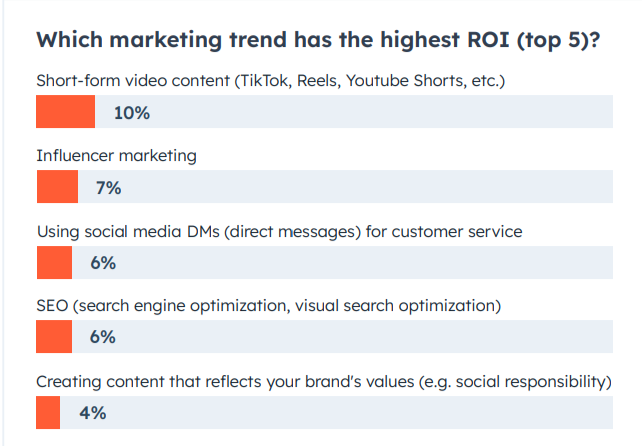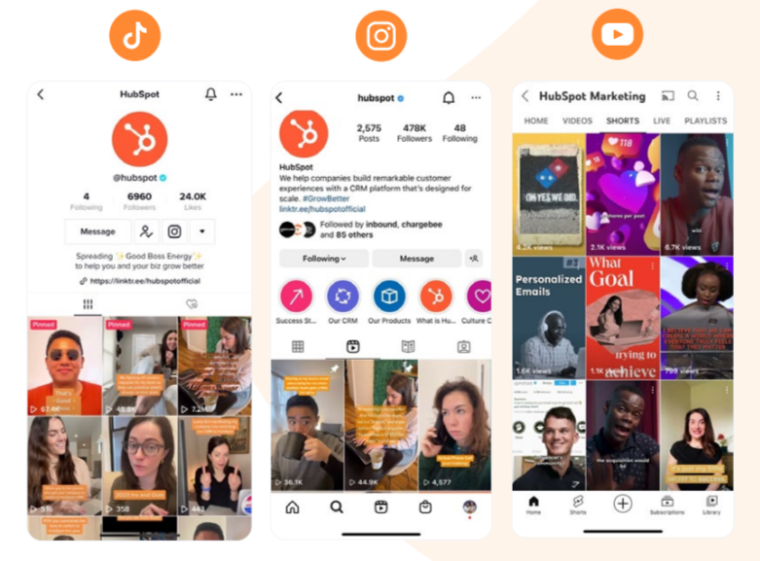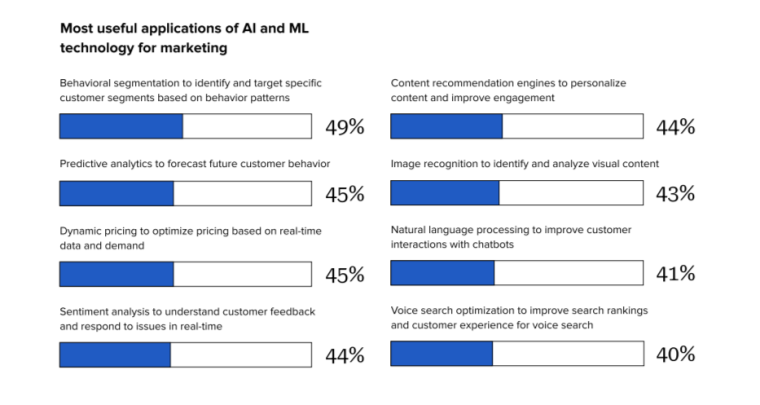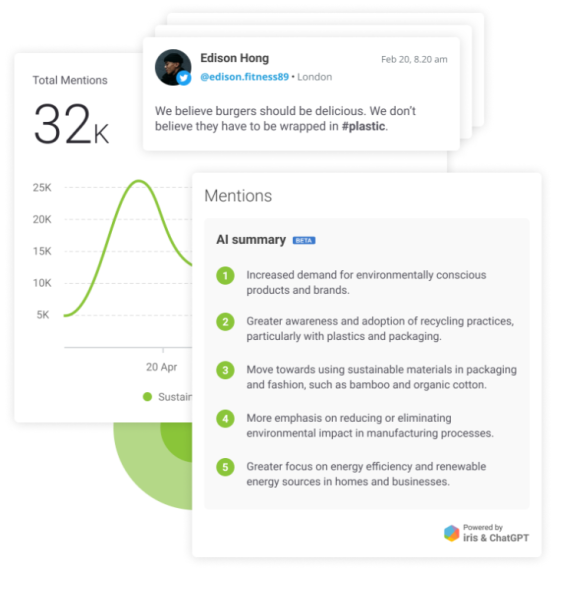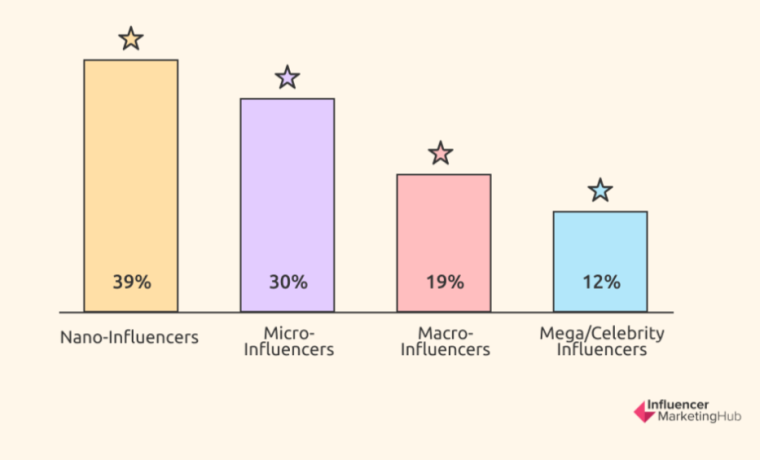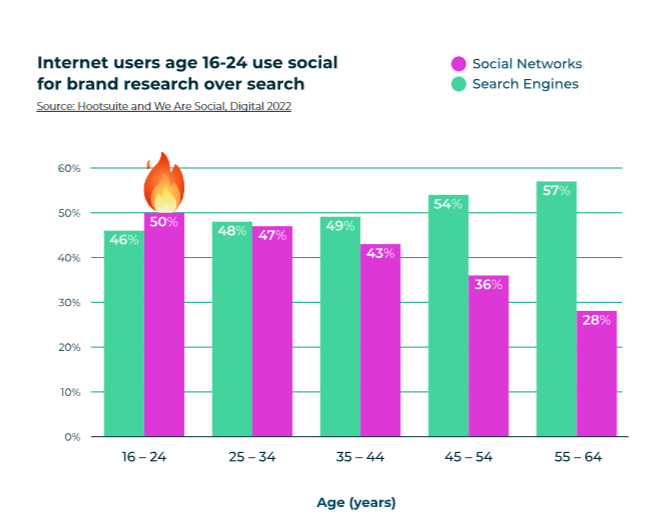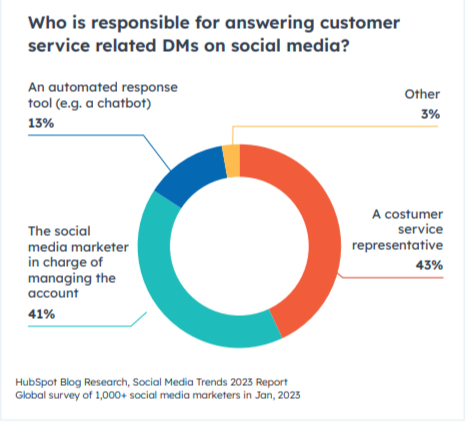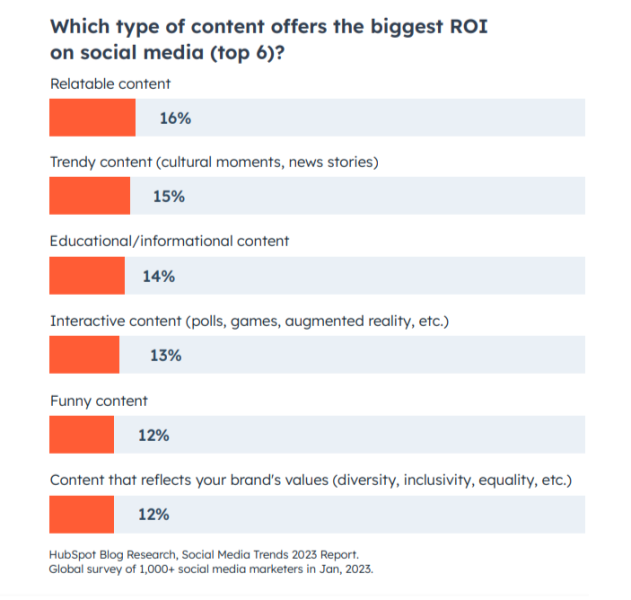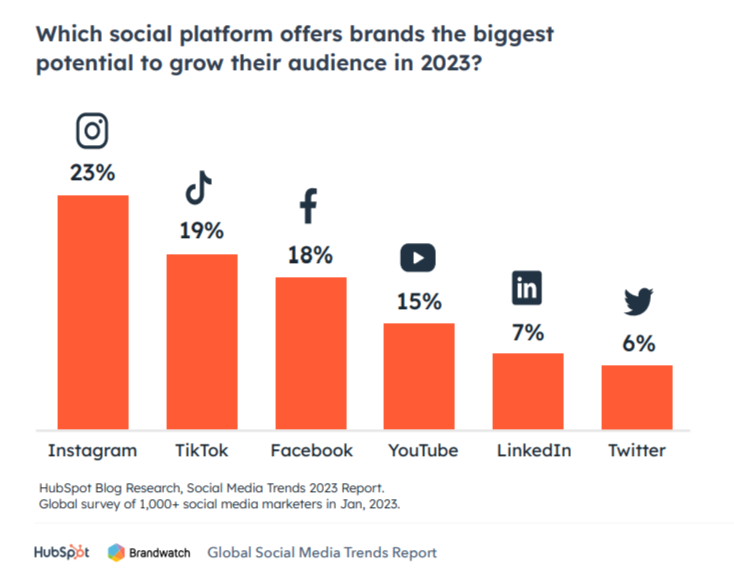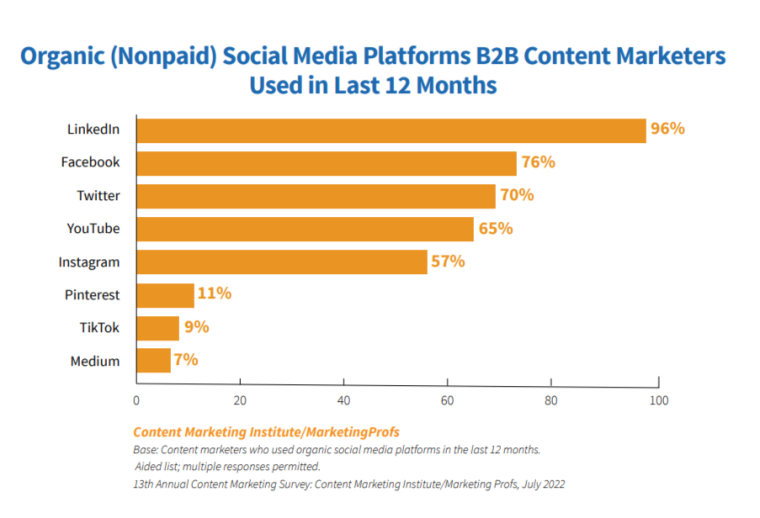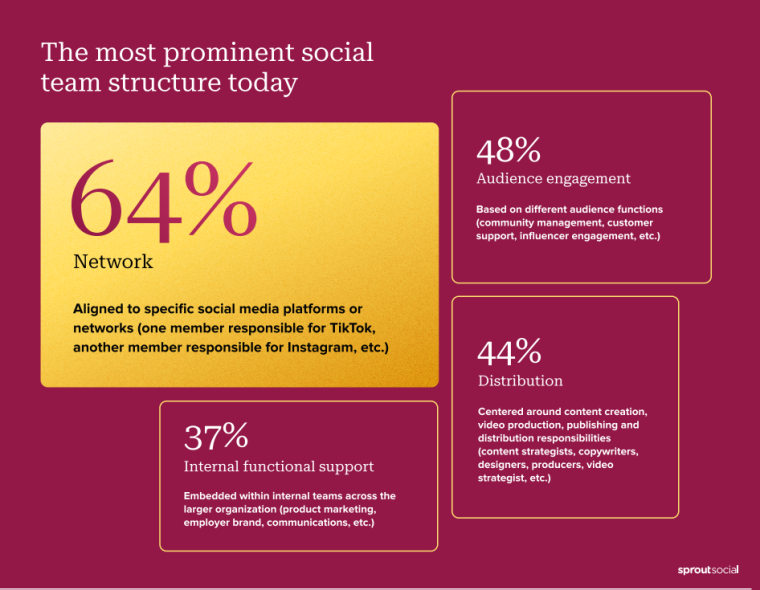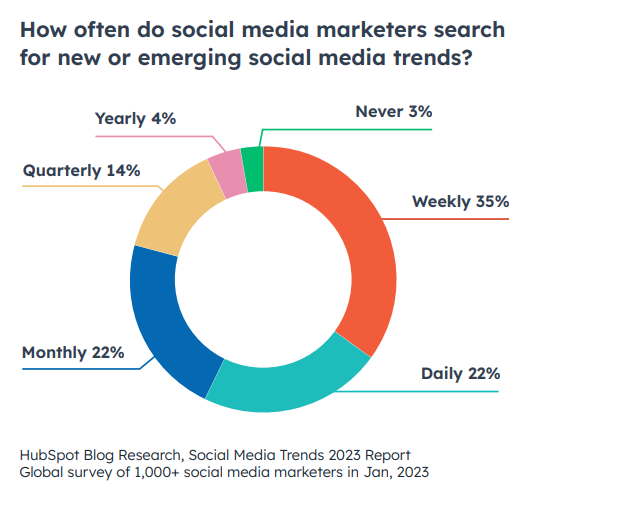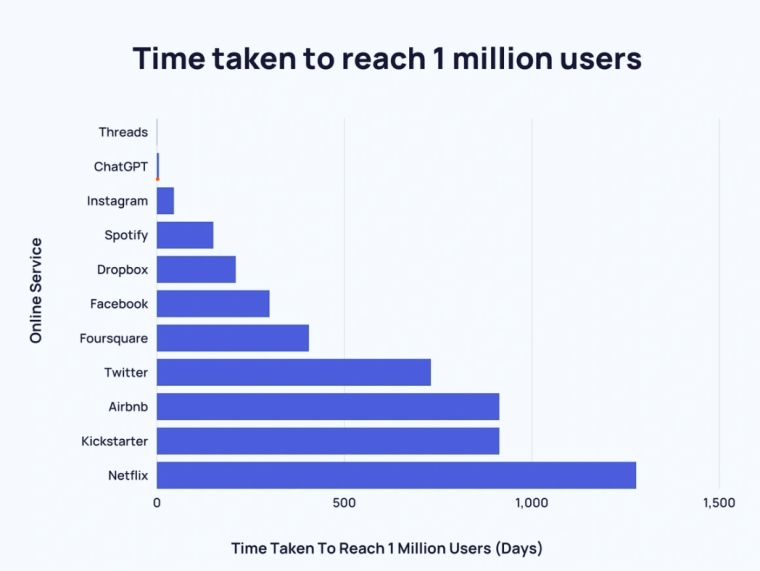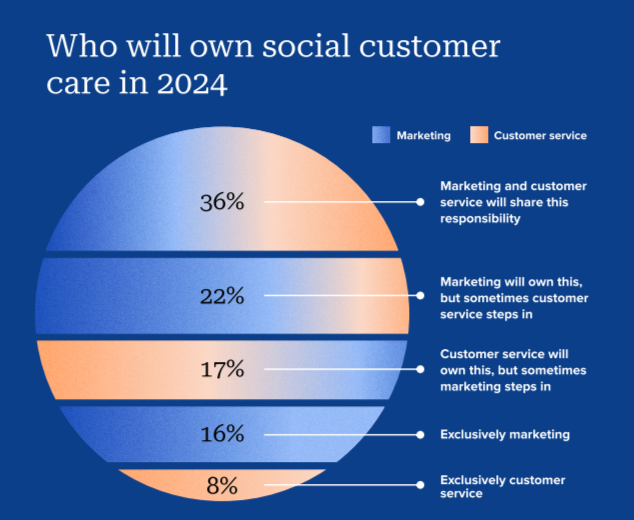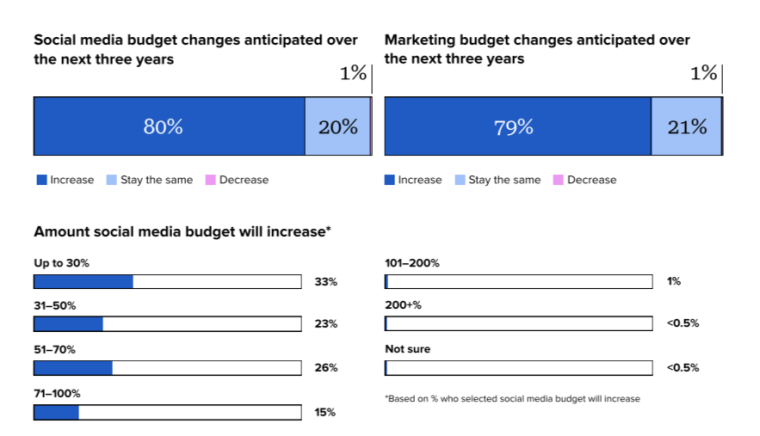Marketers use social media trends to connect with their target audience, develop an effective content creation strategy, and stay relevant in the ever-changing social media scene. However, these trends often shift depending on technological advancements, user preferences, and statistics, making them extraordinarily difficult to follow closely.
Social media trends in 2023 highlight the importance of short-form video content, UGC, influencers, social search, and more. For this article, Business2Community has gathered the most interesting stats, trends, and future predictions about the latest social media trends for you to take advantage of.
Key Social Media Trends for 2025
- Short-form video content was the marketing trend that saw the highest ROI in 2023.
- Mentions of UGC increased by 76% between 2021 and 2022, according to data from Twitter, Reddit, Instagram, Facebook, blogs, forums, and review sites.
- 80% of businesses managed to attract high-quality leads and customers after running social media campaigns with influencers.
- For 89% of social media marketers, social search was an important part of their social strategy in 2023.
- 80% of companies planned on increasing their social media budget for three years from 2023.
What are 2025‘s Social Media Trends?
According to HubSpot’s State of Marketing Report, short-form video content shared on social media platforms such as TikTok, Instagram, and YouTube Shorts saw the highest ROI in 2023. Besides short-form videos, using social media DMs for customer service also ranked high on the list.
The same HubSpot study also stated that 33% of marketers planned to prioritize short-form social media videos as a part of their strategy, suggesting that they follow the latest trends.
By keeping up with the top social media trends, companies can boost engagement, create interesting opportunities, and expand their reach. For example, almost 30% of Gen Z and Millennials bought products directly on social media as of 2022, which suggests that an up-to-date social strategy can lead to more sales.
Here are the top social media trends for 2023:
1. Short-Form Video
A budget-friendly way of creating engaging content, short-form video content is the top area marketers invested in for 2023.
“In 2023, to save money, marketers can lean into one of the big trends in short-form video — low-budget, casual videos. You don’t need expensive full-studio production to be hip right now. Your smartphone, a sense of humor, and a call to action might be all it takes to create the perfect video for your brand,” said Justin Pohl, associate marketing manager at HubSpot.
Brands especially create short-form video content to reach Gen Z and Millennials, as these audiences prefer dynamic videos to learn about new products.
As for social platforms, companies choose to post on TikTok, Instagram Reels, and YouTube Shorts. Below are examples of HubSpot’s social media accounts where it continuously shares short-form video content.
Another good example of a company using short-form video content is the Washington Post. With over 1 million followers on TikTok, the company has shown that it’s possible to communicate serious news stories by using video content. Thanks to its strong TikTok presence, the Washington Post has also managed to gain thousands of Gen Z followers.
2. User-Generated Content
As opposed to content created by brands, user-generated content (UGC) consists of written content, videos, or images created by users themselves. Data gathered from public posts on Twitter, Reddit, Instagram, Facebook, blogs, forums, and review sites showed that mentions of UGC increased by 76% between 2021 and 2022.
Moreover, 30M unique social media authors mentioned “reviews,” “advice on,” “pros and cons,” “alternatives,” and “best option,” on Twitter. When they search for these terms, consumers come across UGC and get unique insights from real customers.
HubSpot predicted UGC to be one of the efficient ways brands can grow their Instagram account in 2023. As Katie Slayford, a Social Media Executive at Brandwatch, pointed out, today, more people rely on social media for recommendations. This includes reading other people’s reviews instead of looking at content created by the brand.
Incorporating UGC into the company’s marketing strategy will help create more authentic content for target audiences, while showcasing real people’s opinions and improving credibility.
3. AI in Social Media
In social media, AI is used for strategy building, performance analysis, image generation, automation, and customer service chatbots.
97% of business leaders agreed that artificial intelligence and machine learning technologies help analyze data and insights more efficiently. Overall, marketers felt positive about AI, with 81% saying that it has already had a positive impact on their work. Currently, almost half of marketers use AI for behavioral segmentation, predictive analysis, and dynamic pricing.
Since AI has become such a big topic in social media, more businesses started developing their own AI tools to provide better services to their users. Social media suite Brandwatch is one of these companies. Its AI tool Iris helps identify the latest insights, provides writing assistance, and gives actionable data about how social content has performed.
4. Influencer Marketing
The State of Influencer Marketing 2023: Benchmark Report found that 23% of companies intended to spend more than 40% of their marketing budget on influencer marketing. And more than half of the survey respondents said that they wanted to increase their marketing spending for influencer content.
Similar to UGC, influencer marketing also helps build trust and attract new customers. 80% of the Influencer Marketing Hub survey respondents said they attracted high-quality leads and customers as a result of their influencer marketing campaigns.
In 2023, brands preferred working with nano and micro-influencers instead of macro-influencers, both for budget reasons and for their authenticity and high engagement rates. Precisely, 39% of companies chose to collaborate with nano-influencers (1,000-10,000 followers) and 30% chose micro-influencers (10,000-100,000). Less than 20% chose macro-influencers (100,000-1 million followers) and celebrities.
“Marketers increasingly partner with influencers because it works. People trust recommendations from creators they follow,” said James Creech, Senior Vice President of Influencer Strategy at Brandwatch.
“More and more marketers are working with influencers on performance-driven campaigns, optimizing for down-funnel metrics like app installs or purchase conversions. As a result, performance-focused marketers often work with mid-sized creators and emerging talent rather than traditional celebrities and macro-influencers,” he added, confirming the popularity of nano and micro-influencers.
When it comes to social media channels brands use for influencer content, TikTok took the lead as the most popular app for 55.5% of the brands. Other social media channels brands used were Instagram, Facebook, and YouTube.
5. Social Search
89% of social media marketers considered social search as a part of their social media strategy. This is for several reasons. For example, in 2022, Gen Z used TikTok more than Google as the primary source of information. Hootsuite’s Social Media Trends 2023 report also showed that users aged between 16 and 24 had a preference for social media over search engines when researching brands.
“A great starting point is choosing relevant keywords, increasing accessibility, and capitalizing on hashtags within your niche,” said Erin McCool while talking about the importance of optimizing content for social search.
Besides brands, people use the search function to find other users, interesting content, or products to buy. In 2023, 58% of people used social search to find other users, 57% to find interesting content, and over 30% searched for brands, ideas, and products or services to buy.
6. Social Commerce
With the rise of UGC, influencer marketing, and social search, social commerce has become an exciting trend.
6 in 10 business leaders have integrated social commerce software into their social media marketing (SMM), facilitating the social buying process for users. For social selling platforms, Instagram offers the highest ROI, followed by Facebook, YouTube, TikTok, and Twitter.
That said, Hootsuite’s Social Media Trends 2023 Report stated that there were still trust issues with social selling. 37% of marketers said that social buyers were most probably concerned with entering payment information on social platforms.
To gain customers’ trust, the report suggests offering easy returns and refunds, displaying ratings and reviews transparently, and informing buyers about their order’s status.
Similarly, HubSpot recommended using testimonials, data-driven brand research, and UGC to address customers’ concerns.
7. Social Customer Service
“As many marketers struggle to take a greater role in customer service, great ones stand out,” stated Hootsuite’s Social Media Trends 2023 Report.
In Social Sprout’s 2023 State of Social Media Report, 62% of business leaders said that customer services were directly informed by social media data. Indeed, as of January 2023, around 1 in 5 Gen Z, Millennial, and Gen X social media users DM’ed brands for customer service in the past 3 months.
Moreover, in 41% of companies, social media marketers were in charge of answering customer service DMs, ranking just below the customer service team.
13% of survey respondents used chatbots. A key trend in social customer service, chatbots can be efficient for a company’s social media strategy in the long run. According to a Userlike survey, 68% of consumers liked how quickly chatbots replied, and very few thought companies shouldn’t use them at all.
8. Original and Educational Content
When asked what type of content offered the highest ROI, the top three responses were relatable, trendy, and educational content.
“Creativity and authenticity are key to success on social,” stated Sprout Social’s Social Index 2023. Especially when people discover a brand, they expect to see authentic content that showcases brand values. Other branded content that seems salesy and fake is much less effective at driving sales. According to the report, 45% of social media users follow a brand thanks to its fun and entertaining content.
Here are the types of content brands could post more in 2023, according to Sprout Social:
- Authentic, non-promotional content
- Transparency about business practices and values
- Information about how products are made or sourced
- Educational content related to the brand’s industry
- User-generated content or customer testimonials
HubSpot’s Global Social Media Trends 2023 also reported a need for creating relatable and educational content. Brands interested in the latest social media trends should also consider creating funny posts, producing interactive content such as polls, games, or AR/VR experiences, and sharing the behind-the-scenes views of their company.
9. Social Media Platforms With the Highest ROI
23% of SMMs noted Instagram as the best source of ROI, engagement, and quality leads, which makes the social media app the most efficient platform to grow an audience. After Instagram, 19% of marketers preferred TikTok, 18% Facebook, and 15% YouTube.
More than 50% of the marketers surveyed planned on investing more in Instagram and using its latest business features, optimizing posts and captions, putting product links in Instagram stories, and sharing user-generated content.
On the B2B content marketing side, LinkedIn dominated as the best social media platform for organic engagement. According to Content Marketing Institute’s 2023 B2B Content Marketing Survey, 96% of marketers used LinkedIn between July 2021 and July 2022.
10. Adaptable Social Media Marketing Teams
As different platforms launch new features and customer preferences shift, the social media landscape also changes. For example, 100 million users signed up for Threads in less than a week after it was launched.
To keep up with the latest social media trends, social teams need to be aware of the changes in different social apps.
According to Nycole Hampton, Senior Director of Social at GoodRx, the head of social must be plugged into everything going on across the organization to develop ideas on how social can help. Today, around 64% of social teams are organized by the social network. This means that one person manages TikTok while another is in charge of Instagram, and so on.
According to Sprout Social, this can create knowledge gaps and redundancies, hence the need for adaptable social media teams. 48% of social teams are organized based on audience functions, such as community management, customer support, and influencer engagement.
The Future of Social Media
57% of social media marketers check the latest trends daily or weekly. These trends not only help them stay up to date but also help adapt their social strategy for future trends.
Here are some trends that will shape the future of the social media landscape.
Artificial Intelligence
Using AI to automate marketing tasks enables the marketing team to spend more time on creative projects.
Over four in ten marketers said that the number of campaigns they work on each quarter increased from 2021 to 2022, with no signs of slowing down. With AI in the picture, marketers can focus on the tasks AI cannot perform.
Gabby Pinto, Chief Creative Officer of CXD Studio, said
“By taking advantage of automated tools for everyday brand content, like visual CTAs, email updates, and social media images, we predict that creative teams will be able to spend more time on complex marketing projects and brand storytelling campaigns,”
Generative AI tools like writing assistants, image generators, and chatbots will also continue growing in importance for social media marketers. In February 2023, ChatGPT became the fastest-growing app in history (before Meta’s Threads outdid it), suggesting that there are many more opportunities for generative AI beyond 2023.
“While some may worry that AI will replace elements of their craft, savvy marketers should embrace these new tools as complementary to irreplaceable human elements of marketing — instinct, creativity, and empathy — to launch bold new endeavors,” said Carrie Parker, CMO of Brandwatch.
In the future, marketers will use AI tools to leverage their work, rather than being replaced by AI.
Social Media in Search, Commerce, and Customer Service
“The transition of search from web to social will be long and generational,” according to Hootsuite’s Future of Social Media Marketing Report. Social search will become increasingly popular but the change from web to social will likely take more time.
Besides search, the use of social media for commerce and customer service will continue growing.
The latest social media trends showed that the place of social media in customer service cannot be ignored. “As the touchpoint for consumers, social media has become the call center, suggestion box, and customer service desk for brands,” said Azad Yakatally, Head of Social Media at Klaviyo.
36% of Sprout Social survey respondents predicted that in 2024, marketing teams and customer services will share the responsibility of responding to customers on social media.
More businesses will implement a solid social media strategy for customer care, including responding to basic customer inquiries with AI, providing training to employees, and using social media management tools.
SMMs will need to consider customer service as a part of building a brand instead of an unrelated field to marketing.
As Hootsuite puts it,
“A brand isn’t just a logo or a promise; it’s a result. It’s a customer’s gut feeling about a product, service, or company. And it’s every marketer’s responsibility to make sure that gut feeling isn’t soured by unanswered DMs.”
We will also be seeing more of social commerce in the future. 80% of social media marketers said that in the future, consumers will buy products directly from social apps rather than brands’ websites or marketplaces like Amazon.
For brands, social selling efforts are likely to be complemented by UGC, influencer marketing, and targeted social ads.
Marketing Budgets
96% of businesses agree that companies must continue investing in social media to be successful in the future. As a result, more businesses will increase their social media and marketing budget from 2023 to 2026.
According to Sprout Social, 80% of companies plan on increasing their social media budget, while only 1% plan on decreasing it. Of that 80%, about 4 in 10 companies plan on increasing their budgets by at least 50%.
Influencers and Creators
Research suggests that people trust influencers. For example, 21% of social media users aged between 18 and 54 made a purchase based on an influencer’s recommendation in the past three months, as of January 2023.
In 2023 and onwards, 8 in 10 marketers expect their companies to have a creator or influencer as their brand’s face, instead of a celebrity. The creator economy is booming, and brands are in favor of smaller creators that have between 1,000 and 100,000 followers.

